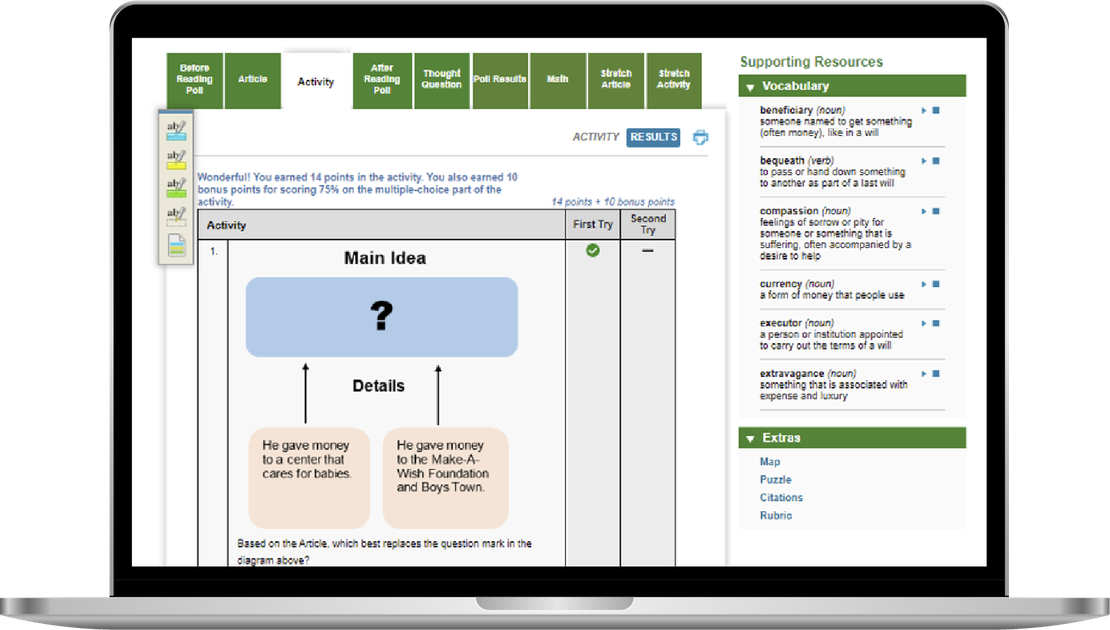Jodi Perrington teaches middle and high school students at Bug-O-Nay-Ge-Shig School in Minnesota.
Celebrating my students success has always been a priority for me; since students have been learning from home, Ive had to make some adjustments, but thankfully many of the initiatives have carried through. We have been using Achieve3000 Literacy as part of our core literacy instruction since 2018. The platform, which uses the Lexile Framework for Reading to assess students reading ability and measure their progress, provides clear goals for our students and allows for many creative ways to engage them in learning and striving to read more.
One of my most successful initiatives was helping students to equate their school work with earning money. I call it “Achieve Dollars”.
Achieve Dollars started out as a classroom-based incentive program that allowed students to earn Achieve Dollars which could then be redeemed for a variety of treats such as chips, cookies, and soda, from our classroom store. We created a point system that would give all students, struggling and advanced, the same chance to earn Achieve Dollars. Students earn points for completing lessons with a 75% score or better on the related assessments. Points were structured in the following way:
75%= 1 point
88%= 2 points
100%= 3 points
10 points = an Achieve Dollar
When students were still in class, they would track their scores using a special handout that I created for them. When they scored points, they marked it on our classroom scoreboard. When they had enough points to bank a dollar, we added a dollar to the classroom bank ledger. It is important that students are self-monitoring as it helps build ownership and provides time for reflection. The classroom scoreboard is an opportunity for celebration. The earning of Achieve Dollars is a way to reward hard work without leaving anyone out.

This incentive program started at the beginning of 3rd quarter, so students knew how it worked before quarantine. Once we shifted to learning from home, students were still able to track their scores on a tracking sheet at home, but I did have to change a few things, but it was worth it as it really helped me to maintain communication with my students. This quarter, I started sending an update on their point balance once each week. At first, it was like a bank statement. It showed the deposits and debits with a balance. After a couple of weeks, I sent a balance notice with instructions on how to place their classroom store order with their advisory teacher who calls daily to check on homework and take attendance. When the orders started coming in, students had an account summary placed in their shopping bag, like a receipt, along with an update on assigned Achieve lessons still waiting to be completed. Not all students want snacks; some students save all their points to turn in for extra credit instead of treats.
The stark truth is that those students that do well in class without my prodding dont really need much encouragement from me now either. The students that I was concerned about before are facing an even harder struggle as they try to work from home. For these students, you cant really wait for them to score a 75% or better before you celebrate. You need to find even the smallest thing to celebrate. I sent a little thank you note with a piece of gum or candy to those students that completed 2 lessons for the week and include encouraging words to those that didn’t get 75% or higher. Also, the first time a student completes a lesson, no matter the score, celebrate. Send something with a see you note. I see you got on to Achieve. Yippee. I hope you enjoyed the article. Here are some others to try. You can personalize the note as much as you want. If you have email addresses for parents, this would be a great chance to send a note to them as well. If the parent has a positive word to share with the student about an Achieve success, you are doubling and making the celebration even more public. Its important that students know they are getting more than a grade. If you are hitting all those internal and external reward buttons for students, they are more likely to build a sense of ownership, to get motivated, and to find value in doing the work.